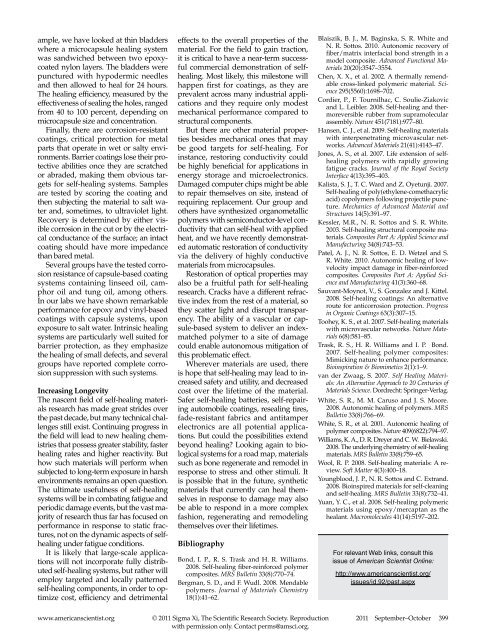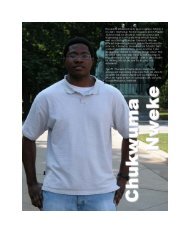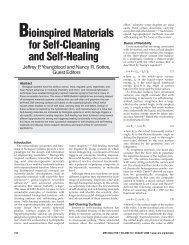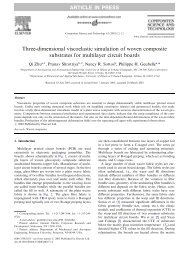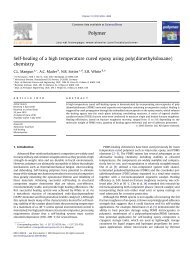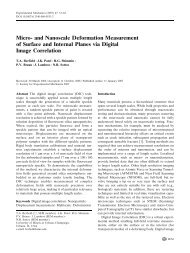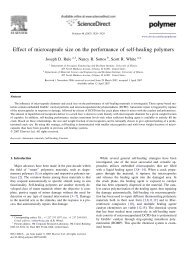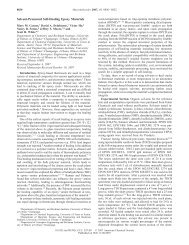Self-healing Polymers and Composites - Sottos Research Group
Self-healing Polymers and Composites - Sottos Research Group
Self-healing Polymers and Composites - Sottos Research Group
Create successful ePaper yourself
Turn your PDF publications into a flip-book with our unique Google optimized e-Paper software.
ample, we have looked at thin bladderswhere a microcapsule <strong>healing</strong> systemwas s<strong>and</strong>wiched between two epoxycoatednylon layers. The bladders werepunctured with hypodermic needles<strong>and</strong> then allowed to heal for 24 hours.The <strong>healing</strong> efficiency, measured by theeffectiveness of sealing the holes, rangedfrom 40 to 100 percent, depending onmicrocapsule size <strong>and</strong> concentration.Finally, there are corrosion-resistantcoatings, critical protection for metalparts that operate in wet or salty environments.Barrier coatings lose their protectiveabilities once they are scratchedor abraded, making them obvious targetsfor self-<strong>healing</strong> systems. Samplesare tested by scoring the coating <strong>and</strong>then subjecting the material to salt water<strong>and</strong>, sometimes, to ultraviolet light.Recovery is determined by either visiblecorrosion in the cut or by the electricalconductance of the surface; an intactcoating should have more impedancethan bared metal.Several groups have the tested corrosionresistance of capsule-based coatingsystems containing linseed oil, camphoroil <strong>and</strong> tung oil, among others.In our labs we have shown remarkableperformance for epoxy <strong>and</strong> vinyl-basedcoatings with capsule systems, uponexposure to salt water. Intrinsic <strong>healing</strong>systems are particularly well suited forbarrier protection, as they emphasizethe <strong>healing</strong> of small defects, <strong>and</strong> severalgroups have reported complete corrosionsuppression with such systems.Increasing LongevityThe nascent field of self-<strong>healing</strong> materialsresearch has made great strides overthe past decade, but many technical challengesstill exist. Continuing progress inthe field will lead to new <strong>healing</strong> chemistriesthat possess greater stability, faster<strong>healing</strong> rates <strong>and</strong> higher reactivity. Buthow such materials will perform whensubjected to long-term exposure in harshenvironments remains an open question.The ultimate usefulness of self-<strong>healing</strong>systems will be in combating fatigue <strong>and</strong>periodic damage events, but the vast majorityof research thus far has focused onperformance in response to static fractures,not on the dynamic aspects of self<strong>healing</strong>under fatigue conditions.It is likely that large-scale applicationswill not incorporate fully distributedself-<strong>healing</strong> systems, but rather willemploy targeted <strong>and</strong> locally patternedself-<strong>healing</strong> components, in order to optimizecost, efficiency <strong>and</strong> detrimentaleffects to the overall properties of thematerial. For the field to gain traction,it is critical to have a near-term successfulcommercial demonstration of self<strong>healing</strong>.Most likely, this milestone willhappen first for coatings, as they areprevalent across many industrial applications<strong>and</strong> they require only modestmechanical performance compared tostructural components.But there are other material propertiesbesides mechanical ones that maybe good targets for self-<strong>healing</strong>. Forinstance, restoring conductivity couldbe highly beneficial for applications inenergy storage <strong>and</strong> microelectronics.Damaged computer chips might be ableto repair themselves on site, instead ofrequiring replacement. Our group <strong>and</strong>others have synthesized organometallicpolymers with semiconductor-level conductivitythat can self-heal with appliedheat, <strong>and</strong> we have recently demonstratedautomatic restoration of conductivityvia the delivery of highly conductivematerials from microcapsules.Restoration of optical properties mayalso be a fruitful path for self-<strong>healing</strong>research. Cracks have a different refractiveindex from the rest of a material, sothey scatter light <strong>and</strong> disrupt transparency.The ability of a vascular or capsule-basedsystem to deliver an indexmatchedpolymer to a site of damagecould enable autonomous mitigation ofthis problematic effect.Wherever materials are used, thereis hope that self-<strong>healing</strong> may lead to increasedsafety <strong>and</strong> utility, <strong>and</strong> decreasedcost over the lifetime of the material.Safer self-<strong>healing</strong> batteries, self-repairingautomobile coatings, resealing tires,fade-resistant fabrics <strong>and</strong> antitamperelectronics are all potential applications.But could the possibilities extendbeyond <strong>healing</strong>? Looking again to biologicalsystems for a road map, materialssuch as bone regenerate <strong>and</strong> remodel inresponse to stress <strong>and</strong> other stimuli. Itis possible that in the future, syntheticmaterials that currently can heal themselvesin response to damage may alsobe able to respond in a more complexfashion, regenerating <strong>and</strong> remodelingthemselves over their lifetimes.BibliographyBond, I. P., R. S. Trask <strong>and</strong> H. R. Williams.2008. <strong>Self</strong>-<strong>healing</strong> fiber-reinforced polymercomposites. MRS Bulletin 33(8):770–74.Bergman, S. D., <strong>and</strong> F. Wudl. 2008. Mendablepolymers. Journal of Materials Chemistry18(1):41–62.Blaiszik, B. J., M. Baginska, S. R. White <strong>and</strong>N. R. <strong>Sottos</strong>. 2010. Autonomic recovery offiber/matrix interfacial bond strength in amodel composite. Advanced Functional Materials20(20):3547–3554.Chen, X. X., et al. 2002. A thermally remendablecross-linked polymeric material. Science295(5560):1698–702.Cordier, P., F. Tournilhac, C. Soulie-Ziakovic<strong>and</strong> L. Leibler. 2008. <strong>Self</strong>-<strong>healing</strong> <strong>and</strong> thermoreversiblerubber from supramolecularassembly. Nature 451(7181):977–80.Hansen, C. J., et al. 2009. <strong>Self</strong>-<strong>healing</strong> materialswith interpenetrating microvascular networks.Advanced Materials 21(41):4143–47.Jones, A. S., et al. 2007. Life extension of self<strong>healing</strong>polymers with rapidly growingfatigue cracks. Journal of the Royal SocietyInterface 4(13):395–403.Kalista, S. J., T. C. Ward <strong>and</strong> Z. Oyetunji. 2007.<strong>Self</strong>-<strong>healing</strong> of poly(ethylene-comethacrylicacid) copolymers following projectile puncture.Mechanics of Advanced Material <strong>and</strong>Structures 14(5):391–97.Kessler, M.R., N. R. <strong>Sottos</strong> <strong>and</strong> S. R. White.2003. <strong>Self</strong>-<strong>healing</strong> structural composite materials.<strong>Composites</strong> Part A: Applied Science <strong>and</strong>Manufacturing 34(8):743–53.Patel, A. J., N. R. <strong>Sottos</strong>, E. D. Wetzel <strong>and</strong> S.R. White. 2010. Autonomic <strong>healing</strong> of lowvelocityimpact damage in fiber-reinforcedcomposites. <strong>Composites</strong> Part A: Applied Science<strong>and</strong> Manufacturing 41(3):360–68.Sauvant-Moynot, V., S. Gonzalez <strong>and</strong> J. Kittel.2008. <strong>Self</strong>-<strong>healing</strong> coatings: An alternativeroute for anticorrosion protection. Progressin Organic Coatings 63(3):307–15.Toohey, K. S., et al. 2007. <strong>Self</strong>-<strong>healing</strong> materialswith microvascular networks. Nature Materials6(8):581–85.Trask, R. S., H. R. Williams <strong>and</strong> I. P. Bond.2007. <strong>Self</strong>-<strong>healing</strong> polymer composites:Mimicking nature to enhance performance.Bioinspiration & Biomimetics 2(1):1–9.van der Zwaag, S. 2007. <strong>Self</strong> Healing Materials:An Alternative Approach to 20 Centuries ofMaterials Science. Dordrecht: Springer-Verlag.White, S. R., M. M. Caruso <strong>and</strong> J. S. Moore.2008. Autonomic <strong>healing</strong> of polymers. MRSBulletin 33(8):766–69.White, S. R., et al. 2001. Autonomic <strong>healing</strong> ofpolymer composites. Nature 409(6822):794–97.Williams, K. A., D. R. Dreyer <strong>and</strong> C. W. Bielawski.2008. The underlying chemistry of self-<strong>healing</strong>materials. MRS Bulletin 33(8):759–65.Wool, R. P. 2008. <strong>Self</strong>-<strong>healing</strong> materials: A review.Soft Matter 4(3):400–18.Youngblood, J. P., N. R. <strong>Sottos</strong> <strong>and</strong> C. Extr<strong>and</strong>.2008. Bioinspired materials for self-cleaning<strong>and</strong> self-<strong>healing</strong>. MRS Bulletin 33(8):732–41.Yuan, Y. C., et al. 2008. <strong>Self</strong>-<strong>healing</strong> polymericmaterials using epoxy/mercaptan as thehealant. Macromolecules 41(14):5197–202.For relevant Web links, consult thisissue of American Scientist Online:http://www.americanscientist.org/issues/id.92/past.aspxwww.americanscientist.org© 2011 Sigma Xi, The Scientific <strong>Research</strong> Society. Reproductionwith permission only. Contact perms@amsci.org.2011 September–October 399


